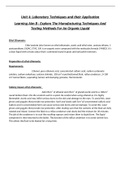Unit 4: Laboratory Techniques and their Application
Learning Aim B : Explore The Manufacturing Techniques And
Testing Methods For An Organic Liquid
Ethyl Ethanoate:
Ethyl acetate (also known as ethyl ethanoate, acetic acid ethyl ester, acetoxy ethane, 1-
acetoxyethane, EtOAC, ETAC, EA) is an organic ester compound with the molecular formula C4H8O2. It's
a clear liquid with a fruity odour that's commonly found in glues and nail polish removers.
Preparation of ethyl ethanoate:
Requirements:
Ethanol, pure ethanoic acid, concentrated sulfuric acid, sodium carbonate
solution, sodium anhydrous calcium chloride, 100 cm3 round bottomed flask, reflux condenser, 2×100
cm3 conical flasks, separating funnel, anti-bumping granules, thermometer.
Making impure ethyl ethanoate:
Add 25cm3 of ethanol and 25cm3 of glacial acetic acid to a 100cm3
round bottom flask. Mix the contents well in a spiral. Be careful when using ethanol as it is highly
flammable. Acetic acid may inflict serious burns to the skin and damage to the eyes. To avoid this, wear
gloves and goggles that provide eye protection. Swirl and slowly add 5cm 3 of concentrated sulfuric acid.
Sulfuric acid in concentrated form can cause serious skin burns and eye damage. To avoid this, wear
gloves and goggles that provide eye protection. After making sure that the contents of the flask are fully
rotated and mixed, Connect the flask to a reflux condenser and slowly boil the mixture for 30 minutes.
The job of the condenser is to cool the resulting vapours and return them to liquid form. The liquid
component is then returned to the boiler. The function of the reflux condenser is to avoid solvent loss.
This allows the flask to be heated for a long time.
, Purification of the impure ethyl ethanoate:
(Step 4-6) Pour the impure ester into a 20cm 3 separatory
funnel filled with water. Shake the separatory funnel with the stopper attached. Please have a stopper.
Separate the layers before pouring a denser water layer from the soil. Repeat steps 4-6 to hold the
organic layer in the funnel. You need to add about 25cc of sodium carbonate solution. Inhalation of this
chemical can cause respiratory irritation, coughing, shortness of breath, and pulmonary oedema. Eye
contact can cause long-term corneal damage and burns. To avoid this, wear a mask and goggles.
Close the funnel, turn it upside down several times, and open the faucet from time to time until the
bubbles disappear. Separate the two layers, drain carefully and discard the lower layer. Store the top
layer in a separatory funnel. Pour off the aqueous layer and wash the remaining organic layer with
roughly 20cm3 of distilled water. Fill a clean, dry Erlenmeyer flask halfway with ethyl acetate, then shake
vigorously with a spatula full of solid anhydrous calcium chloride. Ethyl acetate can be harmful to your
health if inhaled or absorbed through the skin. The skin, eyes, nose and throat can be irritated by ethyl
acetate. High levels of exposure can cause dizziness, light-headedness, or fainting. Regular contact with
the skin can cause the skin to dry and crack. To avoid this, use gloves, face masks, gloves, lab coats,
and safety goggles. Pour the liquid into a clean, dry 100cm 3 round-bottom flask and top it up with some
impact-resistant granules. Install a thermometer with a range of 0-100 degrees Celsius inside a
distillation equipment. Collect pure ethyl acetate by heating the flask.
Distillation:
Distillation is a technique for extracting liquid (the solvent) from a mixture and retaining the
liquid fraction. Distillation converts the liquid into vapor, which in turn condenses it back into a liquid.
When the vapor from the kettle condenses on a droplet of distilled water on a cold surface, it appears at
the most basic levels. Distillation is a technique for separating a liquid from non-volatile particles. B.
Fermented materials from alcoholic beverages, or two or more liquids with different boiling points. B.





